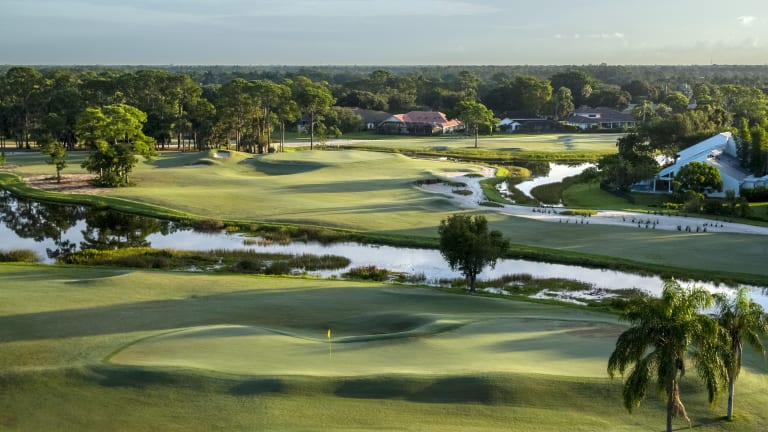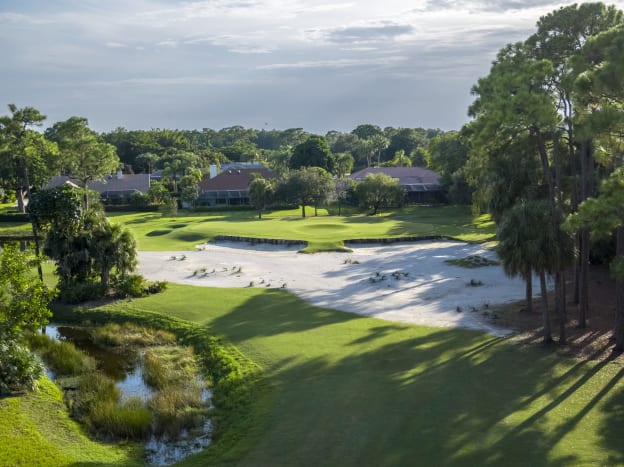
The Match Course Has No Equal (or Par, Course Rating), Plenty of Novelty

PALM BEACH GARDENS, Fla. — At first, Jane Broderick, longtime director of golf and former head professional at PGA National Resort in Palm Beach Gardens, Fla., couldn’t believe her ears. Now she can’t believe her eyes.
When architect Andy Staples pitched the resort’s ownership team a rather radical change for PGA National’s existing Squire course — an 18-hole layout specifically designed for match play — Broderick hesitated.
"I was probably one of the of the ones that said, wait a minute," she says. "But as soon as Andy finished his whole thought process, he had me hook, line and sinker. It was just so cool. People have tried to make other changes, i.e., Foot Golf, speed golf, etcetera, but a lot of it has not gotten very far. I think this we can really carry through fully."
In Ireland or the United Kingdom, match play is a preferred format. But in the United States, stroke play is standard. The U.S. touring professionals only play three match-play events — the Ryder Cup (played at PGA National in 1983), the Presidents Cup and the WGC-Dell Technologies event in Austin, Texas. But PGA National, home to four other 18-hole courses, including the Champion Course, which hosts the PGA Tour’s Honda Classic this week, rolled the dice with something different.
That was the basis of Staples’ pitch in January 2020 to the resort's ownership, Brookfield Asset Management of Toronto, after he had been hired to create a new short course.
“I said I’ve been in that area and know what the courses are like,” recalled Staples. "I look at your scorecards and see the ratings and slopes. You’ve got difficulty covered, so I want to give you an option that gives you the ability for customers to say I actually had fun on this golf course. At that point, I didn’t know we would be completely into a match course and a par-3 course. All I said was that it’s gotta be fun, relaxed, open to the ground game, have wide fairways and less bunkers, and sustainability should be our mantra."
The Match











Simply named The Match, the engaging 5,841-yard layout debuted last year without specific tees (channel markers denote the back and front of the general tee area), no par for each hole and no course rating. The naked tee areas are a bit disconcerting at first, but that’s quickly outweighed by the fun of shrinking or lengthening holes depending on the state of the match.
"We had a golf committee meeting recently and the committee voted to not even discuss rating The Match for one year," says Broderick, who was named club manager of PGA National Members Club in 2019. "I think that by staying the course and pushing the vision a little bit we’re just going to get more and more people, and they will realize that it’s okay to be different. We are even allowing fivesomes and sixsomes out there given the format.”
Seasonal green fees with a cart are on the high side: $217 from June through September and peaking at $302 January through April. But it’s still short of the Champion Course, which peaks at $491 for green fee, cart and forecaddie from January through April.
Built on land formerly occupied by the 2nd through 17th holes of the Squire Course, The Match has just 19 sand bunkers, with plenty of mounds and rolls in the fairways providing some strategic elements. “I contend that golfers would rather four-putt than lose balls off the tee all day long,” Staples says. The former is a distinct possibility given the fire he put into and around the distinctive green complexes.
“That’s where The Match will show its teeth,” he says. “Greens are perched up with significant roll-offs. But the recovery shots aren’t just a standard wedge you have to get up in the air; you can hit a putter or 7-iron or wedge. That’s part of the fun factor.”
Designing a course for match play provided Staples with a creative freedom absent when stroke play is the primary focus.
"That mainly comes around the green and the length of holes,” he says. “The fair police will come out all day long to my greens on The Match course because those are designed to challenge your short game. If you’re playing a match I don’t really care if a green is too steep or too anything; it’s just a matter of getting the ball in the hole."
Golfers can receive a card that describes all the different formats of play possible on The Match. “We’ve had strong interest from our women members who told us they didn’t have a clue but wanted to learn about match play,” says Broderick. “With our normal Thursday Ladies’ Day groups, they’re playing The Match one Monday a month just to learn match play because they want to be educated. So that’s been kind of neat.”
So is The Staple Course, which also debuted last year with nine holes ranging from 48 to 135 yards. Green fees range from $53 to $64 to play the walking-only routing. But it’s The Match that Broderick says is a course that is to the golf industry as snowboarding is to the ski industry.
“I just think we’re on a tipping point of really making an impact,” she says. “Even amongst our membership, we have some people that are saying, ‘We want it rated, we want to be able to post our scores.’ And then you have this whole bigger faction of younger folks and even my peers in the industry who are reaching out and saying you guys are so lucky that you’re able to something different.”
Staples points out to doubters of the format that they are likely already playing a form of match play. “I tell them that because you shouldn’t be recording a score if you’re picking the ball up after your 8,” he says. “You lost the hole. But the golf industry drives the idea of a legitimate, or a championship golf course, around a series of norms and standards. Not all courses need to change, but at least enough could to foster that style of golf. If we did that more people would enjoy the game. It’s okay to play a match and not have to worry about recording a score.”
If The Match concept turns off more golfers than it attracts, the fix for PGA National Resort is simple: just add tee markers, establish pars per hole, and have the course rated. Staples is maintaining an optimistic yet realistic stance on the future of the concept.
“As much as I would love to see match play become the standard in our country, I’m not going to hold my breath,” says Staples. “But I will keep trying.”
The new courses are part of an ongoing $100 million resort-wide renovation, which includes a new spa, multiple new restaurants and updated rooms. It all makes up for the biggest series of changes by far during Broderick’s 36-year tenure at PGA National Resort.
“People have said to me in my career, ‘It’s so busy there. Why do you stay? You work so hard,’" she says. "And I’ve always said I want to be here when PGA National reaches its full potential and I think we’re finally going to get there.”
